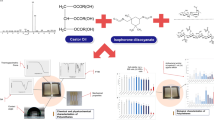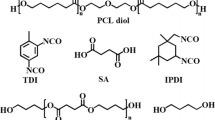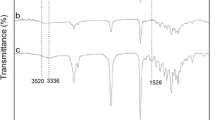Summary
New biomedical polyurethanes and a polyurethane urea based on Ε-caprolactone and 1,4-butanediisocyanate have been developed. On degradation, only non-toxic products are produced. The polyurethane urea with poly(Ε-caprolactone) soft segments and butanediisocyanate/butanediamine hard segments shows a high tensile strength, a high modulus and a high resistance to tearing but as a result of the strong interactions between the solvent and the polymer processing is difficult. When butanediamine is replaced by butanediol in the chain extension step, a processible polyurethane is obtained but the polymer lacks the desired mechanical properties for biomedical applications. By chain extending with a longer urethane diol block, a processible polymer was obtained with mechanical properties comparable to the polyurethane urea. This polyurethane has been made porous and can be used as a meniscal prosthesis.
Similar content being viewed by others
Author information
Authors and Affiliations
Additional information
Received: 12 March 1998/Accepted: 27 March 1998
Rights and permissions
About this article
Cite this article
Spaans, C., de Groot, J., Dekens, F. et al. High molecular weight polyurethanes and a polyurethane urea based on 1,4-butanediisocyanate. Polymer Bulletin 41, 131–138 (1998). https://doi.org/10.1007/s002890050343
Issue Date:
DOI: https://doi.org/10.1007/s002890050343




